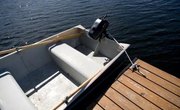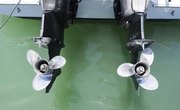
If you go out on the water at all, it's a good idea to know how to operate a boat throttle. It's a fairly simple process. You have only two gears, forward and reverse, so you don't have to worry about shifting gears. On most boats, the throttle consists of one or two levers connected to the engine by cables. On smaller outboard motors, the throttle is controlled by twisting the hand grip on the engine's tiller arm.
One-lever Throttle
Start with the throttle in the middle (neutral) position, with the lever arm straight up. The engine should be idling with the transmission in neutral
Slowly push the lever forward to engage the forward gear. The further you push the lever, the faster you will go. To slow the boat, pull the lever back. To stop the boat, pull the lever back to the middle position.
Slowly pull the lever back to engage the reverse gear. The further back you pull the level, the faster you will go. Push the lever back to the middle position to stop the boat.
Two-lever Throttle
Start with the left lever in the middle (neutral) position with the lever arm straight up. This is the shift lever. Pull the right lever all the way down. This lever controls your speed.
Push the left lever forward to shift into forward gear, or pull it back to shift into reverse gear. Always bring the engine to an idle before shifting gears.
Use the right lever to control your speed. Push the lever forward to go faster, pull it back to slow down, and pull it all the way back to bring the engine to an idle.
Hand-grip Throttle
Line up the arrow on the throttle to the "Shift" marking. The throttle is in the hand grip of the tiller that you use to steer the boat. You twist the hand grip to control the throttle.
Move the gear lever on the side of the motor to either the forward or reverse position.
Twist the throttle to speed up. Twist it in the other direction to slow down.
Bring the engine to an idle and change the gear lever to neutral to stop the boat.
References
Writer Bio
Alan Sembera began writing for local newspapers in Texas and Louisiana. His professional career includes stints as a computer tech, information editor and income tax preparer. Sembera now writes full time about business and technology. He holds a Bachelor of Arts in journalism from Texas A&M University.



